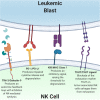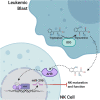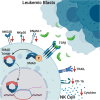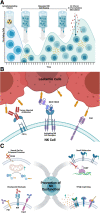Natural killer cell therapy for hematologic malignancies: successes, challenges, and the future
- PMID: 33766099
- PMCID: PMC7992329
- DOI: 10.1186/s13287-021-02277-x
Natural killer cell therapy for hematologic malignancies: successes, challenges, and the future
Abstract
The adoptive transfer of natural killer (NK) cells is an emerging therapy in the field of immuno-oncology. In the last 3 decades, NK cells have been utilized to harness the anti-tumor immune response in a wide range of malignancies, most notably with early evidence of efficacy in hematologic malignancies. NK cells are dysfunctional in patients with hematologic malignancies, and their number and function are further impaired by chemotherapy, radiation, and immunosuppressants used in initial therapy and hematopoietic stem cell transplantation. Restoring this innate immune deficit may lead to improved therapeutic outcomes. NK cell adoptive transfer has proven to be a safe in these settings, even in the setting of HLA mismatch, and a deeper understanding of NK cell biology and optimized expansion techniques have improved scalability and therapeutic efficacy. Here, we review the use of NK cell therapy in hematologic malignancies and discuss strategies to further improve the efficacy of NK cells against these diseases.
Keywords: Cellular therapy; Hematologic malignancy; Natural killer cells.
Conflict of interest statement
D.A.L is on the scientific advisory board of the Caribou Biosciences and Courier Therapeutics. He is also on the scientific advisory board, provides consulting, owns stock, and has IP licensed to Kiadis Pharma.
B.P.T has IP licensed to Kiadis Pharma.
M.G.L and H.G.R have no conflicts of interest to disclose.
Figures






Similar articles
-
Leveraging Natural Killer Cell Innate Immunity against Hematologic Malignancies: From Stem Cell Transplant to Adoptive Transfer and Beyond.Int J Mol Sci. 2022 Dec 22;24(1):204. doi: 10.3390/ijms24010204. Int J Mol Sci. 2022. PMID: 36613644 Free PMC article. Review.
-
Recent progress in and challenges in cellular therapy using NK cells for hematological malignancies.Blood Rev. 2020 Nov;44:100678. doi: 10.1016/j.blre.2020.100678. Epub 2020 Mar 20. Blood Rev. 2020. PMID: 32229065 Review.
-
Challenges to the broad application of allogeneic natural killer cell immunotherapy of cancer.Stem Cell Res Ther. 2022 Apr 12;13(1):165. doi: 10.1186/s13287-022-02769-4. Stem Cell Res Ther. 2022. PMID: 35414042 Free PMC article. Review.
-
NK cells as adoptive cellular therapy for hematological malignancies: Advantages and hurdles.Semin Hematol. 2020 Oct;57(4):175-184. doi: 10.1053/j.seminhematol.2020.10.004. Epub 2020 Oct 26. Semin Hematol. 2020. PMID: 33256910
-
Natural killer cells in malignant hematology: A primer for the non-immunologist.Blood Rev. 2017 Mar;31(2):1-10. doi: 10.1016/j.blre.2016.08.007. Epub 2016 Sep 9. Blood Rev. 2017. PMID: 27665023 Review.
Cited by
-
New Orders to an Old Soldier: Optimizing NK Cells for Adoptive Immunotherapy in Hematology.Biomedicines. 2021 Sep 11;9(9):1201. doi: 10.3390/biomedicines9091201. Biomedicines. 2021. PMID: 34572387 Free PMC article. Review.
-
The Future of Natural Killer Cell Immunotherapy for B Cell Non-Hodgkin Lymphoma (B Cell NHL).Curr Treat Options Oncol. 2022 Mar;23(3):381-403. doi: 10.1007/s11864-021-00932-2. Epub 2022 Mar 8. Curr Treat Options Oncol. 2022. PMID: 35258793 Free PMC article. Review.
-
Natural Killer Cell-Mediated Immunotherapy for Leukemia.Cancers (Basel). 2022 Feb 8;14(3):843. doi: 10.3390/cancers14030843. Cancers (Basel). 2022. PMID: 35159109 Free PMC article. Review.
-
The application of autologous cancer immunotherapies in the age of memory-NK cells.Front Immunol. 2023 May 2;14:1167666. doi: 10.3389/fimmu.2023.1167666. eCollection 2023. Front Immunol. 2023. PMID: 37205105 Free PMC article. Review.
-
NK Cells Armed with Chimeric Antigen Receptors (CAR): Roadblocks to Successful Development.Cells. 2021 Dec 1;10(12):3390. doi: 10.3390/cells10123390. Cells. 2021. PMID: 34943898 Free PMC article. Review.
References
-
- Pizzolo G, Trentin L, Vinante F, Agostini C, Zambello R, Masciarelli M, Feruglio C, Dazzi F, Todeschini G, Chilosi M, Veneri D, Zanotti R, Benedetti F, Perona G, Semenzato G. Natural killer cell function and lymphoid subpopulations in acute non-lymphoblastic leukaemia in complete remission. Br J Cancer. 1988;58(3):368–372. doi: 10.1038/bjc.1988.221. - DOI - PMC - PubMed
-
- Khaznadar Z, Boissel N, Agaugué S, Henry G, Cheok M, Vignon M, Geromin D, Cayuela JM, Castaigne S, Pautas C, Raffoux E, Lachuer J, Sigaux F, Preudhomme C, Dombret H, Dulphy N, Toubert A. Defective NK cells in acute myeloid leukemia patients at diagnosis are associated with blast transcriptional signatures of immune evasion. J Immunol. 2015;195(6):2580–2590. doi: 10.4049/jimmunol.1500262. - DOI - PubMed
-
- Chretien AS, Fauriat C, Orlanducci F, Galseran C, Rey J, Bouvier Borg G, Gautherot E, Granjeaud S, Hamel-Broza JF, Demerle C, Ifrah N, Lacombe C, Cornillet-Lefebvre P, Delaunay J, Toubert A, Gregori E, Luche H, Malissen M, Arnoulet C, Nunes JA, Vey N, Olive D. Natural killer defective maturation is associated with adverse clinical outcome in patients with acute myeloid leukemia. Front Immunol. 2017;8:573. doi: 10.3389/fimmu.2017.00573. - DOI - PMC - PubMed
Publication types
MeSH terms
LinkOut - more resources
Full Text Sources
Other Literature Sources
Medical
Research Materials

